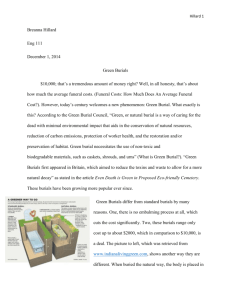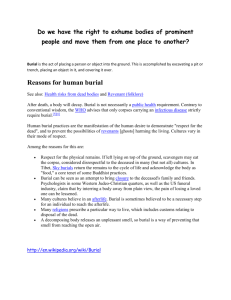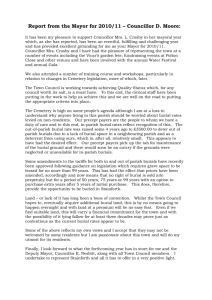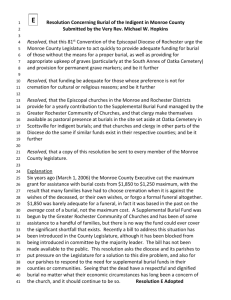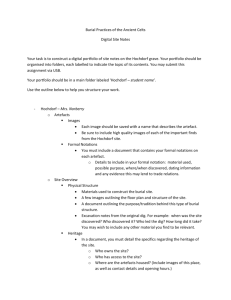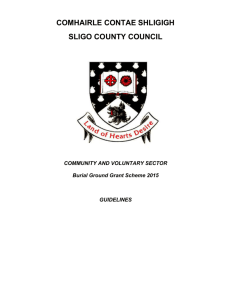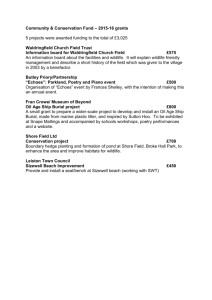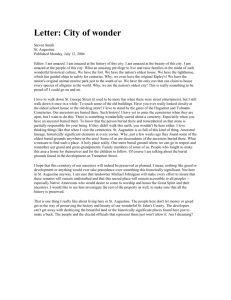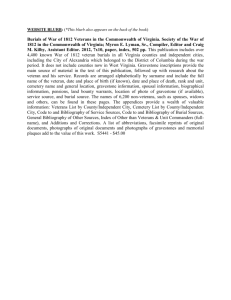Keck Nicole Keck Professor Lotz WRT 150 11 September, 2012
advertisement
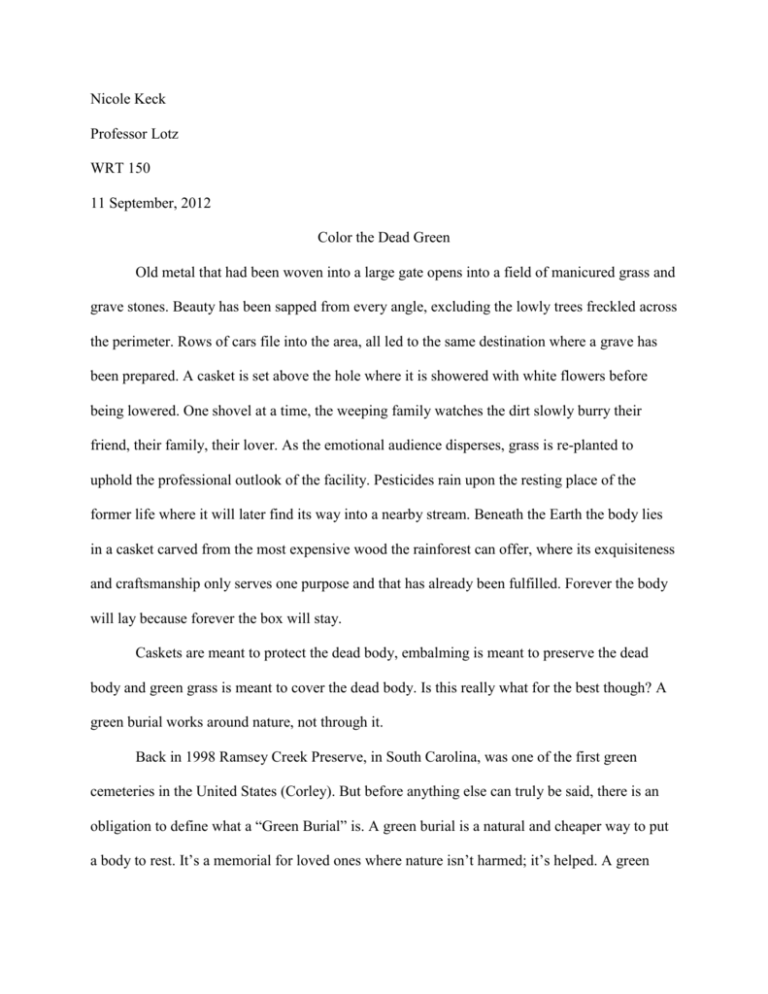
Nicole Keck Professor Lotz WRT 150 11 September, 2012 Color the Dead Green Old metal that had been woven into a large gate opens into a field of manicured grass and grave stones. Beauty has been sapped from every angle, excluding the lowly trees freckled across the perimeter. Rows of cars file into the area, all led to the same destination where a grave has been prepared. A casket is set above the hole where it is showered with white flowers before being lowered. One shovel at a time, the weeping family watches the dirt slowly burry their friend, their family, their lover. As the emotional audience disperses, grass is re-planted to uphold the professional outlook of the facility. Pesticides rain upon the resting place of the former life where it will later find its way into a nearby stream. Beneath the Earth the body lies in a casket carved from the most expensive wood the rainforest can offer, where its exquisiteness and craftsmanship only serves one purpose and that has already been fulfilled. Forever the body will lay because forever the box will stay. Caskets are meant to protect the dead body, embalming is meant to preserve the dead body and green grass is meant to cover the dead body. Is this really what for the best though? A green burial works around nature, not through it. Back in 1998 Ramsey Creek Preserve, in South Carolina, was one of the first green cemeteries in the United States (Corley). But before anything else can truly be said, there is an obligation to define what a “Green Burial” is. A green burial is a natural and cheaper way to put a body to rest. It’s a memorial for loved ones where nature isn’t harmed; it’s helped. A green Keck 2 burial doesn’t take a corpse and roll it into a hole. It uses nontoxic, renewable and biodegradable materials for every aspect of the burial, from embalming to the caskets. The material must be obtained in a fashion that doesn’t harm the environment or it cannot be used. Things such as burial vaults are typically not allowed, seeing as it may harm the very land that this green alternative is trying to preserve. So this begs the question “Should more people opt for a green burial?” Let’s compare a traditional cemetery with a green cemetery. In a traditional cemetery, there is little nature except for the grass that covers the graves and the occasional tree. The organization of Green Burials state that grounds use herbicides that poison the ground and the nearby streams. Also due to the fact they manipulate the elevation of the ground, traditional cemeteries have draining problems (Green Burials). Lawnmowers are used often to contribute to the upkeep where they may cut the grass but they also pollute the air. Then according to ABC’s Carlos Granda, due to the significant amount of dead people there are cemeteries have had to move graves closer together, damaging and disturbing remains. Even through the good and bad, when it is said and done they have tradition and religion that’s been building, growing and changing for centuries. On the other hand, green burials try to have the least amount of influence as possible. Green burial grounds not only host a place for eternal rest but a home for the native species of the area. The ground keepers also do nothing to enhance the growth of the environment so there are no pesticides to pollute the ground or water and since they only use specific, organic material for burials, the carbon footprint is decreased exponentially (Green Burials). So a green burial as a whole still allows a place of memorial for the dead but in a more natural way. With the good comes bad, seeing as there are some potential downs to green burial. One question is if green Keck 3 burials pollute water sources, since the barrier between the body and the soil is pretty much nonexistent. According to Cheryl Corely, from the 90.9 WBUR radio station, “Advocates say water quality will not be jeopardized because, for the most part, harmful bacteria and viruses become inert within hours or days after death” but the graves must be a set distance from any water source anyway. Another is that green burials must happen rather fast because a body must be buried or frozen within twenty-four hours. The cemetery provides freezing, but it could be another potential cost. There is also the concern that people won’t be able to mark graves, let alone find them being green and all. The solution to that is quite easy though. Graves are still able to be marked, just not in the traditional matter. In a green cemetery, native plants and stones are used to mark the graves. There is also the new option of finding the grave via GGPS coordinates (Corely). There is also the possibility that one will be refused a green burial should there be a rare disease or local law preventing it, but those seem to be uncommon chances (Green Burial Pittsburgh). Embalming is one of the issues that almost every green burial article acknowledged. The green cemeteries stress it’s ‘not wrong’ but they don’t allow it because it environmentally unsafe. "We bury enough embalming fluid to fill eight Olympic-size swimming pools, enough metal to build the Golden Gate Bridge, and so much reinforced concrete in burial vaults that we could build a two-lane highway from New York to Detroit" states Joe Sehee, executive director of the Green Burial Council (Corely). The Green Burial Council’s research has also shown that those who have contact with embalming fluid have a higher chance of cancer due to the chemicals within the liquid. If embalming must be used, the Green Burial Council suggests that newer biodegradable embalming fluids are used (Green Burial Council). There are some who say that embalming prevents distribution of diseases. This does not hold true for all, the Green Keck 4 Burial Council disagrees and debates that "there is no evidence suggesting that embalming provides any public health benefits" (Corely). What about vaults? Are they required? According to Green Burial Pittsburg, no they are not required by state nor federal law, but individual cemeteries may require it. To keep grave diggers at bay, vaults used to be required by cemeteries in the late 19th century. Now it’s more of a way to prevent the ground from shifting and to keep grave markers in place. There are a few cemeteries that request an additional charge for grave maintenance on vaultless burials, but most do not. “While the concrete and metal in vaults are considered ‘natural’ to some” it’s not what it seems because “the manufacturing and transporting of vaults utilizes a tremendous amount of energy and contribute to 1.6 tons of reinforced concrete being produced” (Green Burial Pittsburg) for concrete vaults. The Green Burial Council does not require vaults in their certified Hybrid Burial Grounds, but they are not allowed at all in the Natural and Conservational cemeteries (Green Burial Pittsburg). Of all the green ways to go, is cremation one of them? It’s a good, complicated question. Cremation takes fewer resources to accomplish than many of the alternatives but it burns fossil fuels (Green Burial Council). It also emits pollutants such as: dioxin, hydrochloric acid, sulphur dioxide, carbon dioxide and mercury which specifically comes from the cremation of people’s fillings (Green Burials). Newer cremation programs though have new technology to reduce said pollutants to make this way of disposition greener. The Green Burial Council has also started to endorsing facilities that help construct and/or protect ecosystems (Green Burial Pittsburgh). Biodegradable urns are beginning to be available where they are designed to break after a set time. Cremation is not only a greener option for the environment but for your wallet as well Keck 5 seeing as there’s no need for a casket, embalming or burial vault cost (Green Burials). So if a green burial doesn’t fit into your plans well, maybe a cremation will. In the article Burials and Cemeteries Go Green, Cheryl Corely explains why opting for green burials are better. “Each year, cemeteries bury millions of feet of wood, thousands of tons of steel, copper and concrete, and hundreds of thousands of gallons of embalming fluids --which contains formaldehyde, a known carcinogen”. Corley states that green burial is nothing new to us, we are merely returning to the ways of the past and that it goes by the “ashes to ashes, dust to dust” philosophy. Comparison in prices were also made, an average funeral in the United States is easily over $10,000. A green burial is about $2,000 with an additional cost of a casket; a pine casket averages at $420 and a cardboard casket can be as little as $50 (Corley). Aside from prices and money though, green burials benefit the ecosystem as well as conserve it for future generations. People should opt for a green burial. It’s cheaper, and it saves the earth by replenishing it with nutrients and giving the ecosystem a sanctuary away from human development. Green cemeteries are not only obligated to care for the resting place of loved ones, they are also there to guard the environment so it will stay there forever. There isn’t just one way of having a green burial either, there are many ways to fit the many personalities of the world. Keck 6 Work Cited Corley, Cheryl. "Burials and Cemeteries Go Green." 90.9 WBUR. NPR, 16 Dec. 2007. Web. 18 Sept. 2012. Granda, Carlos. "Cemetery Sued for Overcrowded Conditions." ABC News. KABC-TV/DT, 14 Sept. 2009. Web. 29 Oct. 2012. “Green Burials.” GreenBurials.org. GreenBurials.org, 2005. Web. 18 Sept. 2012. “Green Burial Council.” Green Burial Council. Green Burial Council, 2002. Web. 18 Sept. 2012. “Green Burial Pittsburgh.” Green Burial Pittsburgh. Green Burial Pittsburg, 2005. Web. 18 Sept. 2012.
